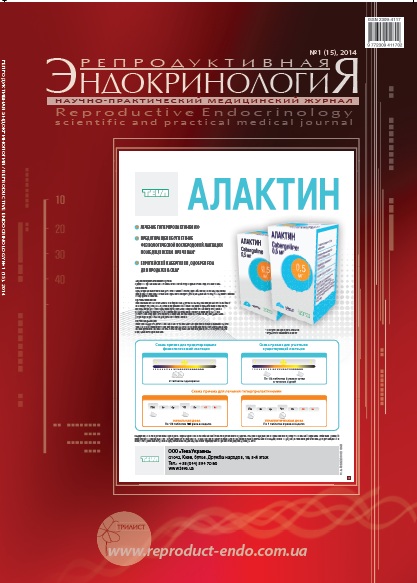Diabetes and pregnancy: happy motherhood. Actual issues in the world and in Ukraine
DOI:
https://doi.org/10.18370/2309-4117.2014.15.84-88Keywords:
pregnancy, diabetes mellitus, blood glucose, insulin, insulin pump, PUMP-therapyAbstract
Diabetes mellitus in pregnancy is associated with more severe pregnancy course and with a higher frequency of adverse perinatal outcomes compared with women without disorders of carbohydrate metabolism. Therefore, until recently it was believed that women with diabetes mellitus can not have children.
Modern management of patients with diabetes mellitus includes non-drug and drug treatment. Women recommended regular self-monitoring of blood glucose, consumption of sufficient amounts of vitamins and minerals, reducing calorie intake and carbohydrates for obesity women, regular physical activity. Insulin is a method of pharmacological treatments for diabetes mellitus that was proven it efficacy and safety for pregnancy and risk of congenital abnormalities.
Currently, the introduction of modern technologies in the treatment of diabetes mellitus has reduced the perinatal mortality rate from 50% to 4%. PUMP-therapy (the use of an insulin pump) is an example of such technology. With the pump, insulin dose by 20–30% lower than after multi-injection. At the same time insulin pump controls blood glucose by itself. PUMP- therapy helps to achieve a vital compensation of diabetes mellitus and allows getting a good course of pregnancy, successful delivery and healthy children.References
- Arbatskaya NY Іnsulin pump – expanded menu experienced user / / Farmateka 2011. – № 16. – P.73 – 77.
- Ragozin AK, Arbatskaya NY, Demidova IY, Kolegaeva OI Gestational diabetes: pathogenesis, diagnosis, management protocols. www. med-m.su/publikatsii-v-presse/blog
- MINISTRY OF HEALTH OF UKRAINE ORDER 01.09.2014 N 0007 On Amending the Order of the Ministry of Health of Ukraine dated July 15, 2011 № 417 «On organization of outpatient obstetric care in Ukraine».
- Hod M, Carrapato M Diabetes and Pregnancy Evidence Based Update and Guidelines (Working group on Diabetes and pregnancy). — Prague, 2006.
- Pickup J, Keen H Continuous subcutaneous insulin infusion at 25 years: evidence base for the expanding use of insulin pump therapy in type 1 diabetes. Diabetes Care 2002; 25 (3): 593–98.
- International Association of Diabetes and Pregnancy Study Groups. International Association of Diabetes and Pregnancy Study Groups recommendations on the diagnosis and classification of hyperglycemia in pregnancy. Diabetes Care – 2010;Vol.335. – N3 – P.676 – 82.
- Gross TM, Kayne D, King A et al. A bolus calculator is an effective means of controlling postprandial glycemia in patients on insulin pump therapy. Diabetes Technol Ther 2003; 5(3): 365–69.
- Jovanovic L, Kitzmiller JL Insulin therapy in pregnancy. In: Hod, H.; Di Renzo, GC.; de Leiva, A.; Langer, O., editors. Textbook of Diabetes and Pregnancy. 2. London: Informa Healthcare; 2008. p. 205 – 216.
- Metzger B, Oats J, Coustan D, Hod M Results of the HAPO study: progress towards a new paradigm for detection & diagnosis of GDM //5th International simposium on Diabetes and pregnancy – Italy – Sorrento. – 2009. – P. – 640.
- Blumer et al. Diabetes and Pregnancy: An Endocrine Society Clinical Practice Guideline Clin Endocrinol Metab. – 2013 – Vol. 98 – p.4227 – 4249.
- Bode BW, Sabbah HT, Gross TM et al. Diabetes management in the new millennium using insulin pump therapy. Diabetes Metab Res Rev 2002; 18(1): 14–20.
Downloads
Published
How to Cite
Issue
Section
License
Copyright (c) 2014 Г. В. Бабина

This work is licensed under a Creative Commons Attribution 4.0 International License.
Authors who publish with this journal agree to the following terms:
- Authors retain copyright and grant the journal right of first publication with the work simultaneously licensed under a Creative Commons Attribution License that allows others to share the work with an acknowledgement of the work's authorship and initial publication in this journal.
- Authors are able to enter into separate, additional contractual arrangements for the non-exclusive distribution of the journal's published version of the work (e.g., post it to an institutional repository or publish it in a book), with an acknowledgement of its initial publication in this journal.







